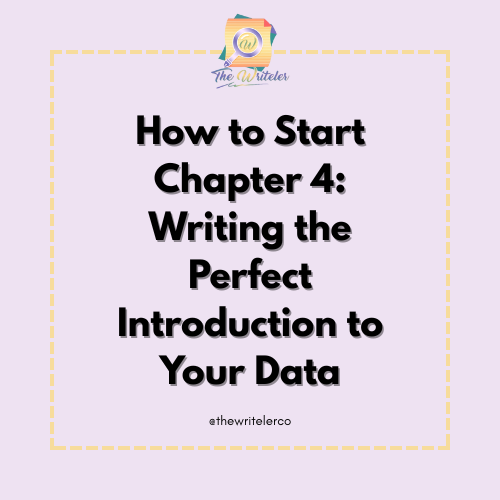You’ve gathered your data, cleaned your tables, and now you’re staring at Chapter 4 wondering, “Do I just dump all these numbers here?”
The short answer? No.
Many students make the mistake of launching straight into data tables without any introduction. But just like any good book or article, Chapter 4 of your thesis or dissertation needs a strong opening. Your reader needs to know what they’re about to see, why it matters, and how to navigate it.
This guide will walk you through how to write a clear, professional, and defense-ready introduction for Chapter 4 — whether you’re working on a quantitative, qualitative, or mixed-method study.
What Is Chapter 4 All About?
Chapter 4 is where you present, analyze, and interpret your data. This is the “meat” of your research — where you answer your research questions and test your hypotheses using real numbers, charts, quotes, or patterns.
But don’t forget: before you dive into the results, you need to give your reader a map. That’s what the introduction is for.
What to Include in the Chapter 4 Introduction
Here’s a simple checklist to build your intro:
✅ 1. Restate the Purpose of Your Study
Start by briefly reminding the reader why you conducted the research in the first place.
📌 Example:
“This study aimed to assess the relationship between time management and academic performance among senior high school students.”
This re-anchors your work so readers know what the upcoming data is trying to answer.
✅ 2. Mention the Data Gathering Process Briefly
You already explained this in Chapter 3, but here, summarize the key details:
- Where and when the data was gathered
- How many participants responded
- Whether the data was gathered through survey, interview, etc.
📌 Example:
“Data were gathered through an online questionnaire administered to 120 Grade 12 students from February to March 2025.”
This gives the reader a quick context refresher.
✅ 3. Describe the Organization of the Chapter 4
Let your reader know how your data will be presented. Will you go by research question? By theme? Chronologically?
📌 Example:
“This chapter is organized by research question. Each section presents relevant tables followed by interpretations and insights based on the results.”
Mention also whether you’ll use charts, tables, graphs, or thematic summaries.
✅ 4. Set Expectations for the Reader
Finally, provide a preview of what’s inside. No need to give away everything — just a glimpse of what types of data or trends you’ll be discussing.
📌 Example:
“The results reveal significant patterns regarding students’ time management habits and their corresponding grade averages. Key statistical tools used include descriptive statistics, Pearson correlation, and regression analysis.”
Sample Paragraph for Your Chapter 4 Introduction
Here’s how a full introduction paragraph might look:
“This chapter presents the findings of the study on the relationship between time management and academic performance among senior high school students. Data were collected from 120 respondents through a structured online survey. The chapter is organized by research question, with each section presenting the relevant data, followed by an analysis and interpretation. Descriptive statistics, Pearson correlation, and linear regression were used to examine the data. The results aim to answer the study’s main questions and provide insight into how students’ time management practices affect their academic performance.”
Simple, direct, and informative — that’s the goal.

Common Mistakes to Avoid
🚫 Jumping straight into tables
You’re not writing a spreadsheet. Introduce the context first.
🚫 Repeating the entire Chapter 3
Keep your summary brief. This is not the time to re-explain methodology.
🚫 Writing a one-liner
An effective introduction should be at least a full paragraph — not just one sentence.
🚫 Forgetting to explain the structure
Your readers aren’t mind readers. Guide them through your data.
Think of this intro as your Chapter 4 elevator pitch — clear, concise, and leading the reader smoothly into your results.
📣 Need Help Writing Chapter 4?
The Writeler Co. is here to support students and professionals who are juggling research with work, life, and business. Whether you’re writing a thesis, capstone, or dissertation for your master’s or Ph.D., we help you efficiently navigate the research journey — from brainstorming to proofreading.
📩 Message us today to get started.
📚 Let’s turn your research idea into a powerful paper.





0 Comments